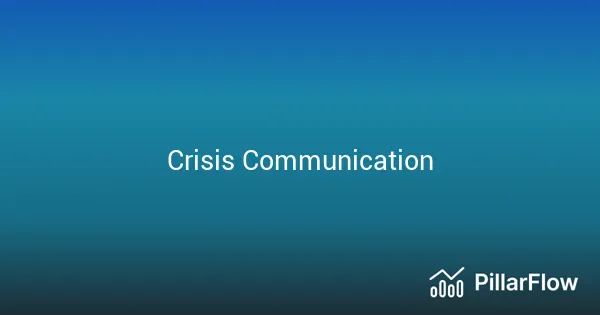Crisis Communication
Learn how to effectively manage and navigate through crises with the document 'Crisis Communication: Navigating Through Turbulent Times'. Discover the import...

Crisis Communication: Navigating Through Turbulent Times
In today's fast-paced and interconnected world, businesses and organizations face an ever-increasing number of potential crises that can threaten their reputation, operations, and even their very existence. Whether it's a natural disaster, a product recall, a data breach, or a public scandal, the way an organization handles communication during a crisis can make or break its ability to recover and regain trust.
Section 1: Introduction to Crisis Communication
Crisis communication refers to the strategic process of effectively managing and communicating with stakeholders during a crisis situation. It involves developing a comprehensive plan, establishing clear roles and responsibilities, and executing timely and transparent communication to minimize the impact of the crisis and protect the organization's reputation.
1.1 Defining Crisis Communication
Crisis communication can be defined as the communication efforts undertaken by an organization to address and manage a crisis situation that significantly impacts its operations, stakeholders, or reputation. It involves providing accurate and timely information, addressing public concerns, and maintaining the trust and confidence of key stakeholders in the midst of a crisis.
1.2 The Role and Importance of Effective Crisis Communication
Effective crisis communication is crucial for organizations to navigate through turbulent times. It serves as a means to protect the organization's reputation, build trust among stakeholders, and mitigate the potential negative consequences of a crisis. Poor crisis communication, on the other hand, can result in increased damage, loss of trust, and a prolonged recovery process.
Section 2: Understanding Crisis Communication Strategies
Successful crisis communication requires careful planning, the utilization of various channels, crafting appropriate messages, and continuous training and exercises to ensure preparedness. This section will delve into the key elements of crisis communication strategies.
2.1 Crisis Communication Planning
Creating a crisis communication plan is the foundation for effective crisis management. This involves identifying potential crises, establishing crisis communication teams and roles, developing a timeline, and defining communication protocols. By having a well-defined plan in place, organizations can respond swiftly and efficiently when faced with a crisis.
2.2 Crisis Communication Channels
In the digital age, organizations have various communication channels at their disposal to disseminate crisis-related information. These include traditional media outlets such as newspapers, television, and radio, as well as digital channels like websites, social media platforms, and email. Additionally, internal communication channels play a vital role in keeping employees informed and engaged during a crisis.
2.3 Crisis Communication Messages
Crafting effective crisis messages requires careful consideration of the concerns and emotions of different stakeholders. These messages should be tailored to address specific issues, be consistent across all communication channels, and reflect the organization's commitment to transparency and accountability. By effectively communicating key messages, organizations can instill confidence and maintain trust during a crisis.
2.4 Crisis Communication Training and Exercises
Preparing for a crisis extends beyond planning and messaging. Organizations must invest in crisis communication training and exercises to ensure that their teams are equipped with the necessary skills and knowledge to respond effectively. By conducting drills and simulations, learning from past crises, and staying up-to-date with best practices, organizations can enhance their crisis communication capabilities.
Section 3: Crisis Communication Strategies in Action
This section explores real-life scenarios where crisis communication played a pivotal role in managing and mitigating the impact of various crises. By examining these case studies, we can gain valuable insights into successful crisis communication strategies.
3.1 Crisis Communication During Natural Disasters
When faced with natural disasters such as hurricanes, earthquakes, or wildfires, organizations must effectively communicate evacuation procedures, safety measures, and recovery efforts. Coordinating with local authorities, providing timely updates, and addressing public concerns are crucial elements of crisis communication during natural disasters.
3.2 Crisis Communication in Product Recalls
Product recalls can pose significant challenges for organizations in terms of consumer trust and brand reputation. Crisis communication in these situations involves notifying customers and stakeholders, providing clear instructions for returning or replacing products, and implementing strategies to rebuild trust and maintain customer loyalty.
3.3 Crisis Communication for Data Breaches and Cybersecurity Incidents
With the increasing frequency of data breaches and cybersecurity incidents, organizations must be prepared to communicate effectively with affected individuals, customers, and the public. This involves notifying those impacted, collaborating with forensic experts and legal teams, and implementing measures to prevent further breaches. Transparent and timely communication is vital to maintaining trust and minimizing reputational damage.
Section 4: Case Studies: Examining Successful Crisis Communication
In this section, we will examine three notable case studies that demonstrate effective crisis communication strategies and their impact on the organizations involved. By analyzing these real-world examples, we can gain valuable insights into best practices and lessons learned.
4.1 Tylenol Poisoning Crisis (1982)
The Tylenol poisoning crisis of 1982 serves as a landmark case study in crisis communication. Johnson & Johnson's swift response, including recalling products, cooperating with law enforcement, and transparently communicating with the public, helped them rebuild trust and set new standards for crisis management.
4.2 Toyota Recall Crisis (2009-2010)
The Toyota recall crisis highlighted the importance of crisis communication in the automotive industry. By acknowledging the issues, taking responsibility, and implementing corrective actions, Toyota aimed to regain customer trust. This case study provides valuable insights into the challenges and strategies involved in recovering from a large-scale product recall.
4.3 United Airlines Passenger Removal Incident (2017)
The United Airlines passenger removal incident in 2017 underscored the impact of poor crisis communication. United Airlines' initial response faced intense public backlash, highlighting the importance of considering public perception and the power of social media in crisis situations.
Section 5: Crisis Communication Best Practices and Future Trends
In this final section, we will explore best practices for effective crisis communication and examine emerging trends that are shaping the field.
5.1 Best Practices for Effective Crisis Communication
We will discuss essential best practices, including designating a crisis spokesperson, being proactive and transparent in communication, and monitoring and managing social media conversations. These practices can help organizations navigate crises successfully and protect their reputation.
5.2 Emerging Trends in Crisis Communication
The landscape of crisis communication is continually evolving. We will explore emerging trends such as the role of artificial intelligence and chatbots in crisis response, managing crises in the age of fake news, and leveraging video and live streaming for real-time crisis updates.
5.3 Crisis Communication Checklist and Resources
To assist organizations in implementing effective crisis communication strategies, we will provide a comprehensive checklist covering key steps in crisis planning and response. Additionally, we will recommend valuable resources, tools, and organizations to support organizations in their crisis communication efforts.
Conclusion: The Importance of Proactive Crisis Communication
Crisis communication is a vital aspect of any organization's risk management strategy. By proactively planning, developing effective communication strategies, and continuously refining crisis response capabilities, organizations can navigate through crises more successfully, protect their reputation, and emerge stronger in the face of adversity.
Author
